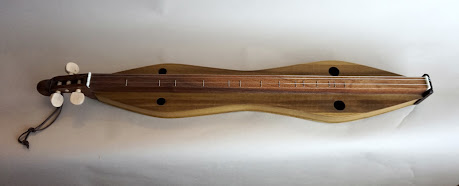The "BETTY"
26 inch Vibrating String Length
When I first started this dulcimore adventure I asked myself, what makes the dulcimore sound like a dulcimore? I read all the books I could find about traditional pieces and those that had measurements I used to make a spread sheet with the sound box dimensions. The median measurements are what I extracted for the “Betty”.
Of course there is more to the dulcimore timber than dimension; poplar was the wood of choice for makers Prichard and Thomas. Placement of the nut and bridge over the very ends of the sound box and three feet to set it off the table top for play are equally important. The use of wooden friction tuners and music wire strings and most importantly, the ratio of weight to mass of the strings to the instrument!
The peg head I designed is simple. It has a ball end to reflect the circle sound holes which are lunar. The tail piece is Thomas “esk”, I’m especially fond of the wide staple the strings break against to protect the wood. Staple frets are driven in a very narrow and very tall fret board, made from the same material as the strings. (Music wire made right here by Mapes in Elizabethton, Tennessee) The staple lay out is diatonic and I have it adjusted to perform in all four modes. I use either shellac or a proprietary hand rubbed oil finish to protect the pieces in a historical way that is far more stable than the contemporary lacquer finishes that are standard today.
Prices start at just $425. All Poplar with your choice of Rosewood, Boxwood or Ebony tuners, shellac or hand rubbed oil finish!



Dan
ReplyDeleteI'd like to buy one of the Betsy models please?
26" scale
6+ fret and octave is that 13+?
Wood nut and bridge.
Very Good!
ReplyDelete